Determining your Level of Play
1.0 Beginner: A beginner is classified as a player who is new to the game, learning scoring and rules or has only played a handful of times. Typically, players are unfamiliar with basic mechanics related to paddle grip, ball striking, or shot preparation and are unaware of foundational rules such as court boundaries, kitchen restrictions, or scoring.
Introduction sessions are designed to build a strong basis for skill development and to invite players to start playing actual games quickly. Techniques and concepts taught include: court safety and awareness, gripping the paddle, basic ball striking, preliminary footwork and scoring.
1.5 Intermediate beginners have spent a small amount of time on the court and are familiar with basic concepts of game play, but skills are underdeveloped.
2.0 Advanced Beginner Players can sustain longer rallies (4 or more shots each point) Can make easier volleys and use backhand more often but need work on stroke development. Start coming to the Non Volley Zone and become more aggressive in their play. Begins to use dinks and lobs but do not fully understand when and where they should be used. Serves become more consistent and working on making it accurate. Knowledge of the rules improves. Court coverage may be weak but improves consistently.
2.5 Advanced Beginner Session play are designed to continue building rudimentary skills. Techniques and concepts learnt include: dinking fundamentals, serve and return concepts, and basic transition. At this level, 2.5 players understand the basic rules such as “two bounce”, scoring, and positioning based on the score and function (serving or receiving). Mechanically, players can hit several dinks in a row, can serve and return accurately more than 50% of the time, can occasionally punch volley and “drop” 3rd shots into the kitchen. The game is primarily focused on ground strokes and mid court volleys. Techniques and concepts practiced include: “Kitchen” restrictions, continued shot mechanics, team movement, and simple transition.
3.0 Players understand all the basic rules, scoring, and positioning. At this point, the focus is on consistency and shot selection. Players should recognise the importance of dinking with “purpose”. Quickness and agility are improving and becoming more important in continuing point rallies. Players should be able to drop 50% of the time from the transition area and 30% - 40% of the time from the baseline, while suitably hitting better than 80% of serves and returns. Concepts like “Serve & Stay” and “Return & Run” should be part of routine game play. Techniques and concepts taught include: court coverage, footwork, “traffic light” shot selection, 3rd shot drops, improved serve/return, lobs, overheads, and team strategies.
3.5 Players understand all the basic rules, scoring, and positioning. Concepts like identifying correct server and receiver are second nature. Dinking and groundstrokes should consistently exceed 70% in terms of accuracy from either the forehand or backhand positions. 3rd shot drops should be attempted at least 50% of the time. Movement forward, up the court, is consistent with the quality of the shot. Serves and returns are dependably deep, and players are developing both offensive and defensive lobs. Hand speed, quickness and mobility are all well developed. Team strategies, like “stacking” are occasionally utilised in game play. Techniques and concepts taught include: sustaining dink rallies using purposeful shot selection, 3rd shot mastery (drive or drop) and transition execution, team strategies, focus on control, playing at multiple speeds (accelerating or taking pace off the ball), and advanced shots (roll overs and drive absorption).
4.0 Players are expected to have full command of the rules and to have mastered most shot techniques. Focus is on full point construction using sound decision making in attempting various shots through serve, return, 3rd and 4th shot strategies, dinking, attacking, resetting, lobbing, and hitting overheads. Players demonstrate a high pickleball IQ and are physically capable of covering court space quickly in efforts to accurately control shots. Team strategies are stressed and advanced shots (ATPs, Ernes, etc.) are implemented. Techniques and concepts learnt include: intense drilling, transition under fire, offensive mindedness with regard to drops and dinks, controlling the point, and using set up techniques to create opportunities.
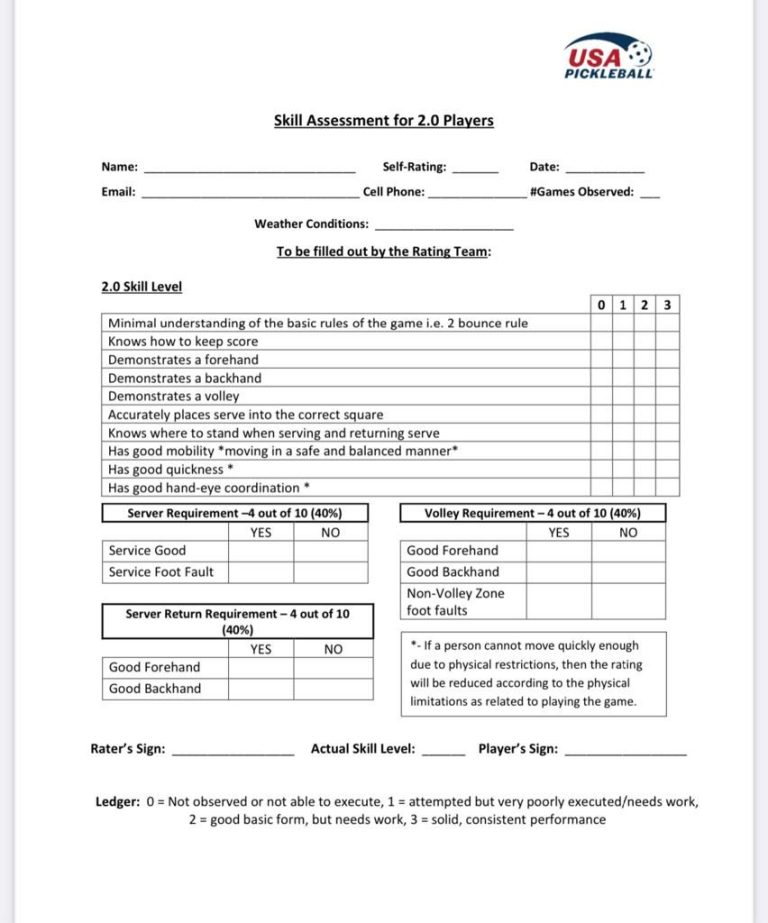
USA Pickleball Skills assessment
Players rate themselves, you can ask other people for their opinion, but that is all it is, their opinion.
There are a few systems out there that will rate you, this requires plenty of tournament play to give an accurate rating. The main system is call DUPR. DUPR stands for Dynamic Universal Pickleball Rating https://mydupr.com/
The pictures here are the USA Pickleball Player Skill Ratings which provides specific skills needed to achieve each level of a player rating. Try and rate yourself from these.
Rating 2.0
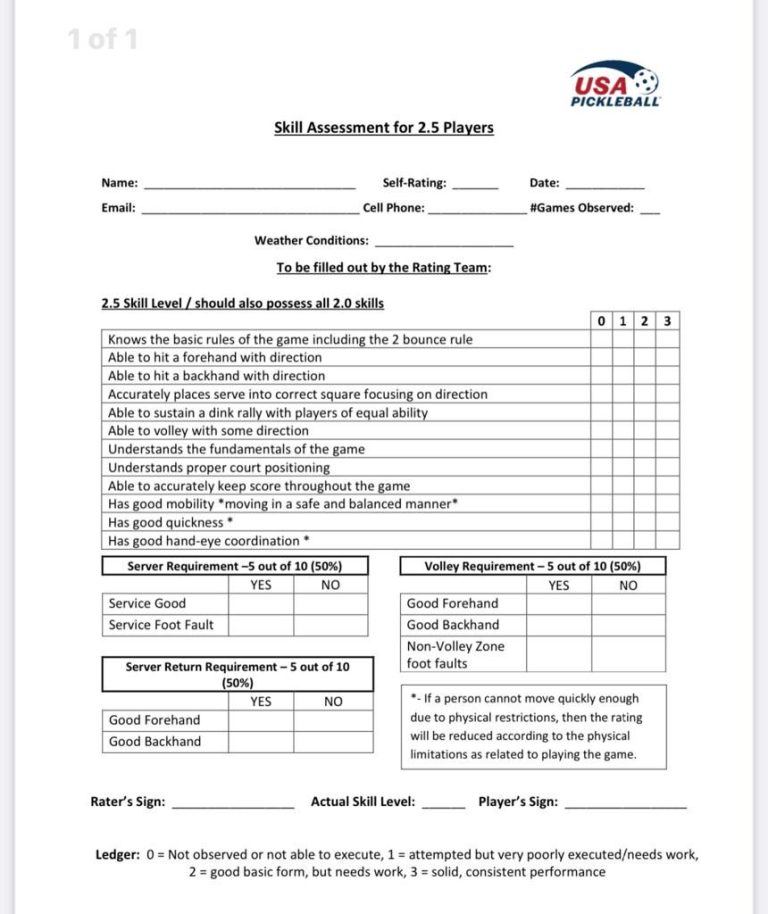
USA Pickleball Skills assessment
Rating 2.5
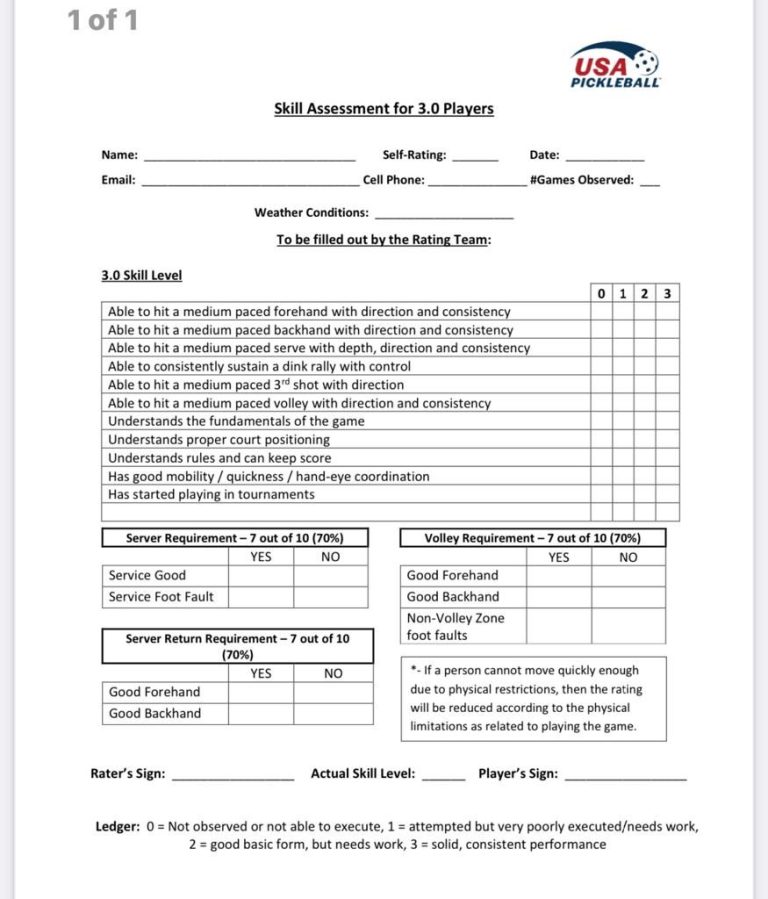
USA Pickleball Skills assessment
Rating 3.0
Do you want to be a 3.0 and above? Have you read the rule book?
USA Pickleball Official Rulebook and Rules Summary
Try this test. It is free and will take between 15 and 50 minutes.
Pickleball Player Test - USAPA Official Testing (usapickleball.org)
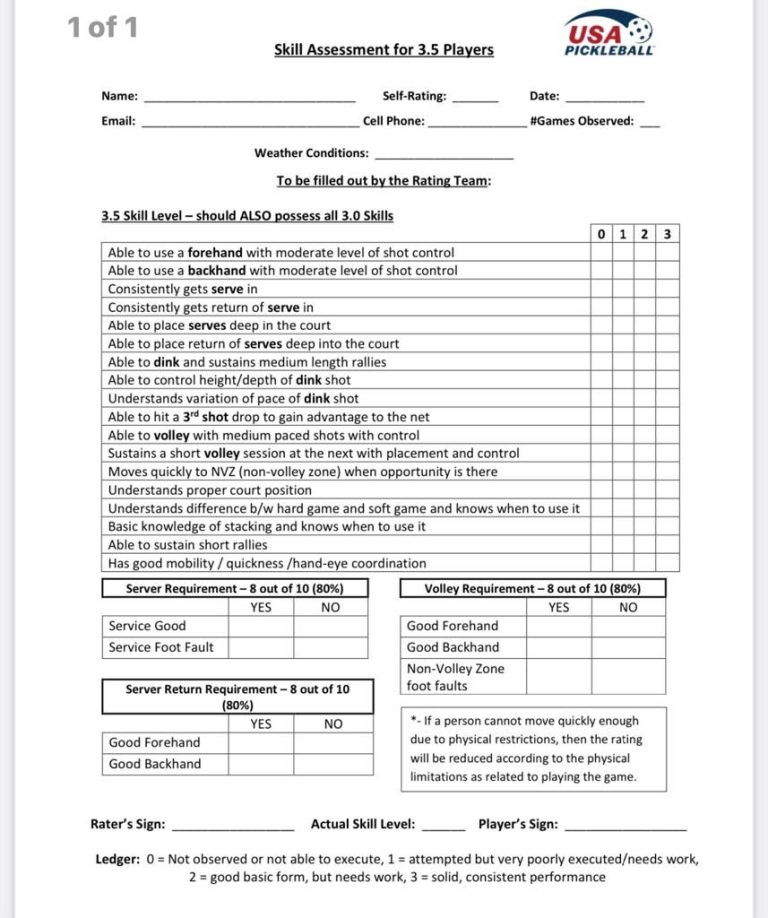
USA Pickleball Skills assessment
Rating 3.5
Do you know this rule?
If a player or referee accidentally calls the wrong score in a pickleball game, the Rules of Pickleball lay out a strict procedure for fixing an incorrect score. If the server or the referee calls an incorrect score, play must continue until the rally is finished, with one team either scoring a point or committing a fault. After the rally ends, any player has the right to call for a correction to be made to the score, but this must be done prior to the next serve. The rules also allow for players to call for a score correction immediately before the initial serve is returned, in which case the score will be corrected and the serve replayed without penalty. If a player calls for a score correction prior to returning the serve, but the score was determined to actually be correct, that player will receive a fault, and their side will lose the rally. A player will also be faulted if they call for play to stop after the initial serve has been returned on account of an incorrect score.
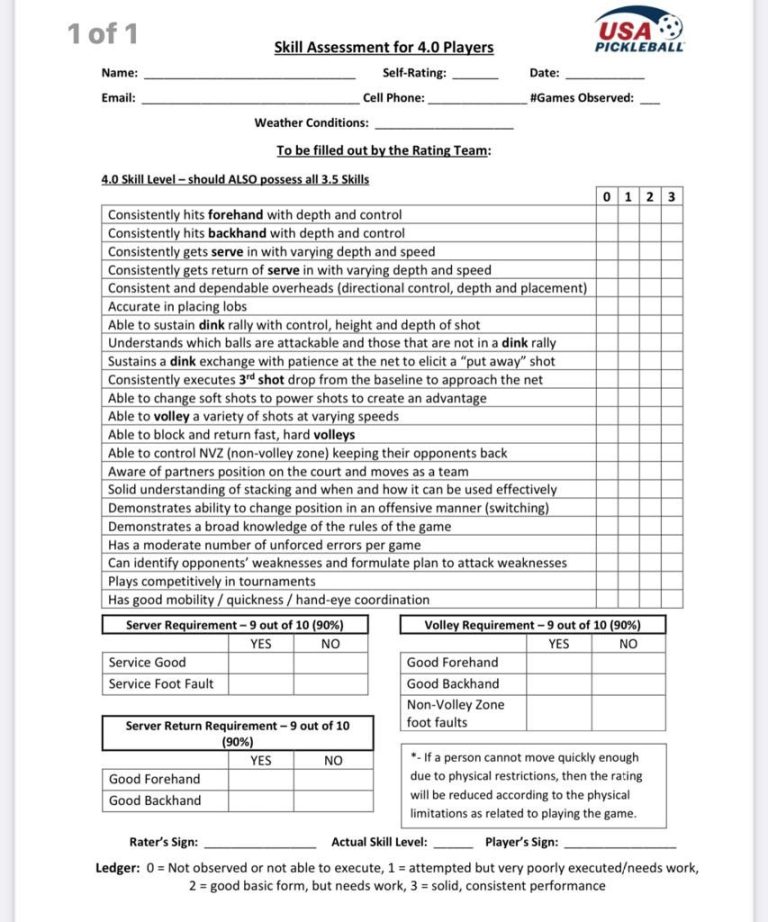
USA Pickleball Skills assessment
Rating 4.0

USA Pickleball Skills assessment
Rating 4.5

USA Pickleball Skills assessment
Rating 5.0+
At the 5.0 and 5.5 skill levels, players are considered elite and often compete in tournaments and at the professional level.
5.0 and 5.5 level pickleball players can execute almost any shot, adjusting speed and depth as needed, and are adept at in-point decision making. 5.0 players limit mistakes and errors, attack when appropriate, and play defensively if the opponent has the advantage.